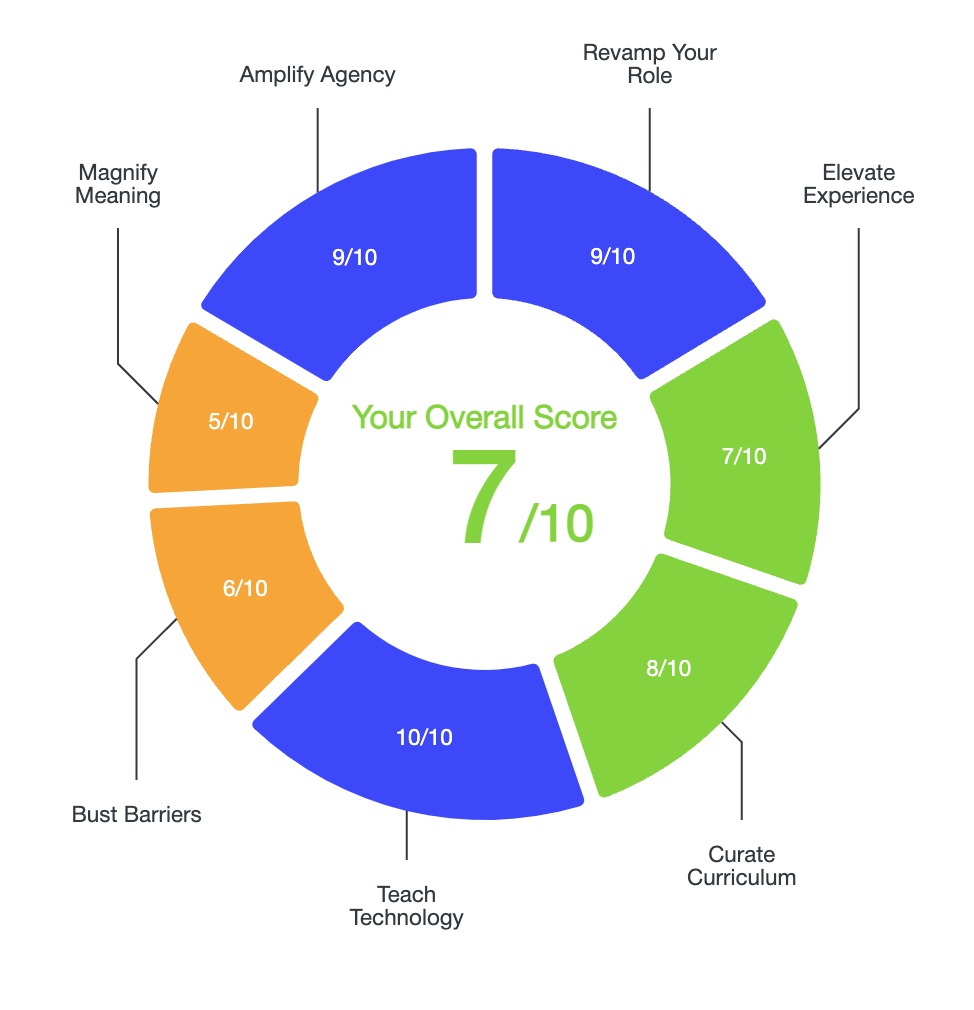Learn how to set up digital interactive notebooks in Google Jamboard for a more interactive alternative to Google Slides or PowerPoint!
Why Use Google Jamboard for Digital Interactive Notebooks?
The reason I think Google Jamboard is a preferable option for digital interactive notebooks than Google Slides is the fact that both you and your students can freely interact anywhere on the board.
With Jamboard, for example, students can use the digital pencil to draw anywhere on the page. Using the textbook tool, they can click anywhere on the board to add text.
Once students add to their notebooks, you can easily jump in and add quick feedback by using the Sticky Note tool, and then students can easily show you that they got your feedback and make revisions if necessary.
It is important to note that right now you can currently only add 20 frames to a single Jam at once, so if you plan to create notebooks longer than 20 pages, you’d have to create separate notebooks, or use Slides instead.
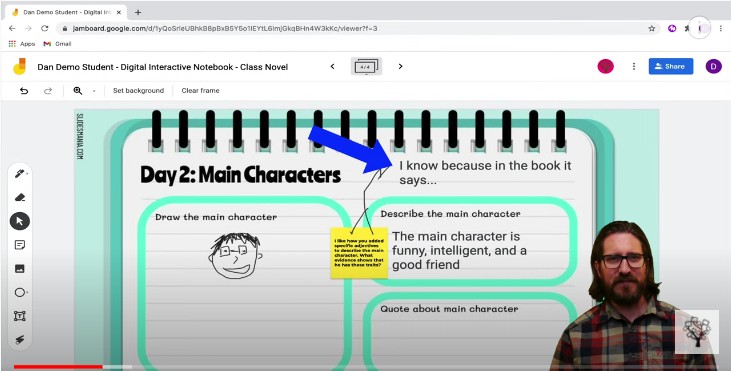
Get Notebook Templates from SlidesMania
In order to start setting up a Jamboard digital interactive notebook, I’d recommend first heading over to SlidesMania to get a notebook template. Although the templates in SlidesMania are labeled Google Slides and PowerPoint templates, you can also easily upload them as Jamboard backgrounds.
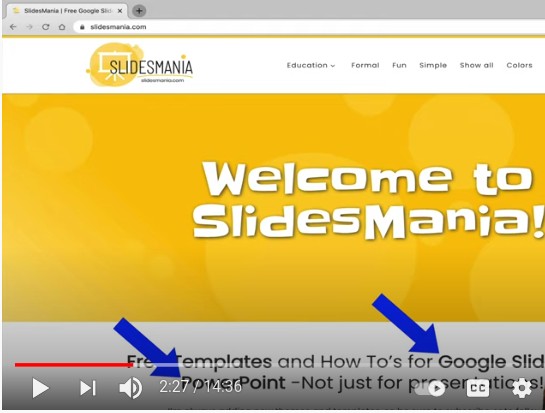
To find notebook templates, I’ll go up to the Education tab in SlidesMania and then select Notebook Style from the drop down menu.

There you’ll see several different notebook style slides that you can download for free.
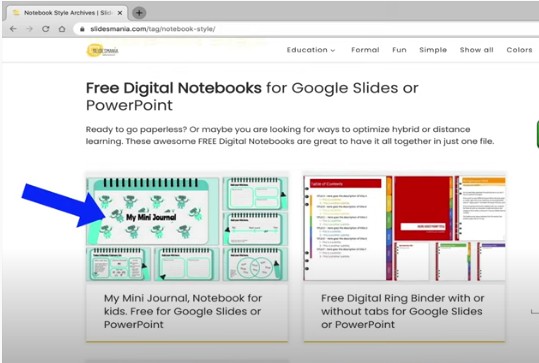
After you click on a presentation, to download it, just click Download PowerPoint or Open in Google Slides.
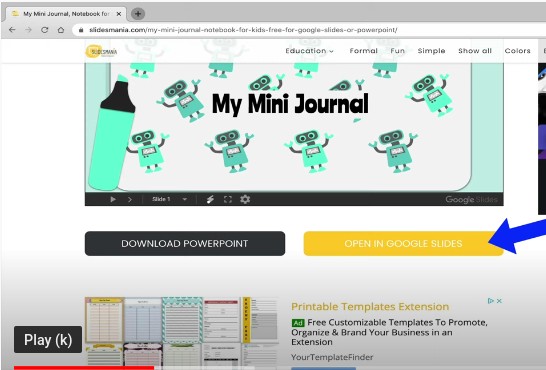

Set Up Your Notebook Template in Google Slides
Before adding this template as a Jamboard background, you’ll want to make whatever changes you plan to make to your notebook in Google Slides since you won’t be able to make those edits once they are in Jamboard.
For example, you could edit this first slide so that students have space to add their own names for their journals.

Then, on the next slide, you can edit the generic text so that it’s customized for the information you want students to input in their notebooks.
For example, if you wanted to set up a digital notebook for students to answer prompts about a book they are reading, you might start by editing the cover slide to include basic instructions as well as give them space to add information about their books.
Then you could set up a checklist that reminds students what they need to do every time they complete a journal entry. For example, you might include that every page needs to reference the pages they read and their answer to the prompt, and that they need to be sure to proofread their responses as well as review teacher feedback and try the extension activity.
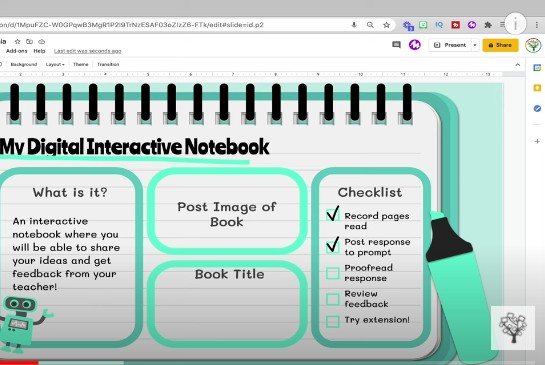
Then, on the next pages, you can start setting up prompts. One option would be to set up all prompts ahead of time and assign them all at once, but if you would prefer to only start with a few prompts and push new ones out to students later, you can do that as well (I’ll explain below).
To give an example of a prompt, you might edit the preset text and type a question asking students to analyze the cover of the book they are reading.
Then, just continue to set up all the prompts you want to push out when you first assign the digital notebook.
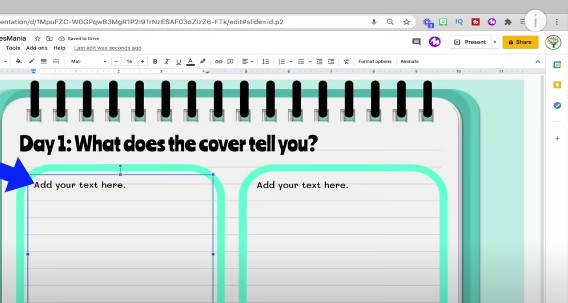
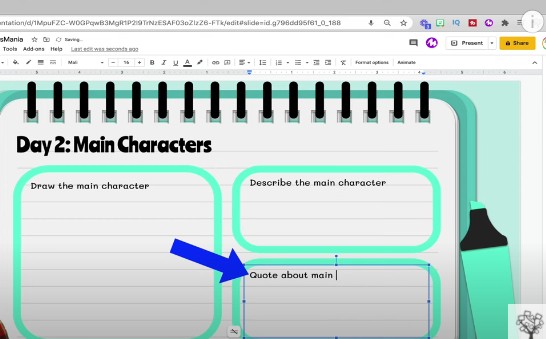
Create a Teacher-Copy and a Student-Copy if You Plan to Drip Out Prompts to Students
If you don’t plan to give all the prompts to students at once, and instead plan to drip out prompts to students along the way, you’ll want to create a ‘Teacher Copy’ of the Slides as well as a ‘Student Copy.’
First, change the name of your Slides to ‘Teacher Copy.’

Next, you’ll want to create a copy of your Teacher Jamboard to create a Student-Facing Version. Be sure to only select the Slide and then go up to File -> Make a Copy, and choose ‘Selected Slides.’
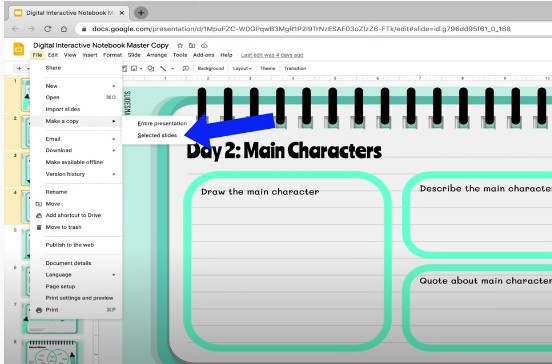
Change the name of this new copy to ‘Student Copy’ instead of ‘Teacher Copy’. Now you should have two separate Slide Decks, one Teacher Copy and one Student-Copy.
Whenever you create new prompts, you’ll want to add them to the ‘Teacher Copy’. Once you complete all the prompts, you’ll have a finished version you can reuse year after year.
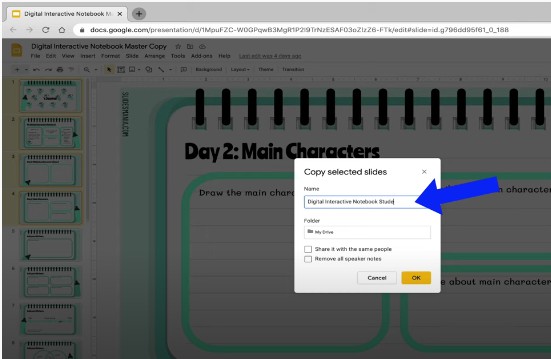
Add Slides Images as Jamboard Backgrounds
Once you’ve set up your notebook in Slides, you’ll need to download them as image files in order to add them as backgrounds in Jamboard.
Do to this, go up to ‘File,’ scroll down to ‘Download,’ and then choose either a JPEG file or a PNG file. Repeat this step until you’ve downloaded all the Slides as image files.
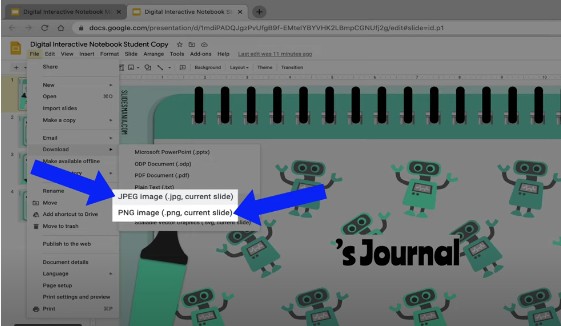
This step is optional, but if you want to keep your files neatly organized, you’ll want to create a folder for the background images you created. You can do this by finding the files you just downloaded, highlighting them, right-clicking, and selecting ‘New Folder with Selection’. That will create a new folder that you can rename ‘Digital Interactive Notebooks’.
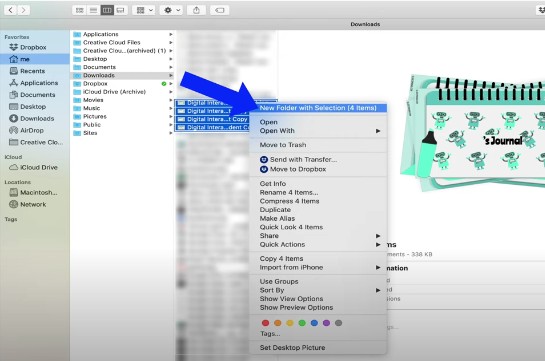
Now that you have your images, it’s time to bring them into Jamboard as backgrounds.
First go over to jamboard.google.com and then click on the orange add button to create a new Jam.
*For a full tutorial on how to use Google Jamboard, be sure to check out this video.
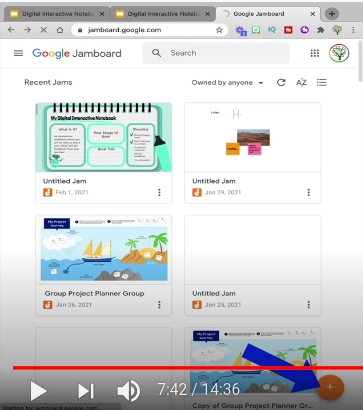
In order to add the Slide you just created as a background, go up to ‘Set Background’ and then choose ‘Image’.
One option would be to find the image on your computer or in your Drive folder. However if you just created a folder with all the images, you can also just drag and drop individual images into Jamboard and you’ll see that they will automatically show up as a background.
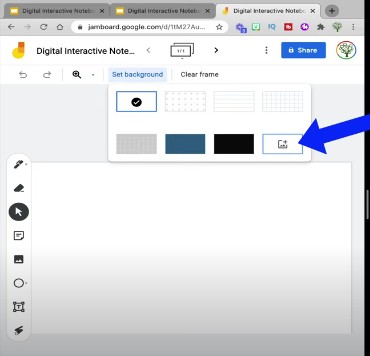
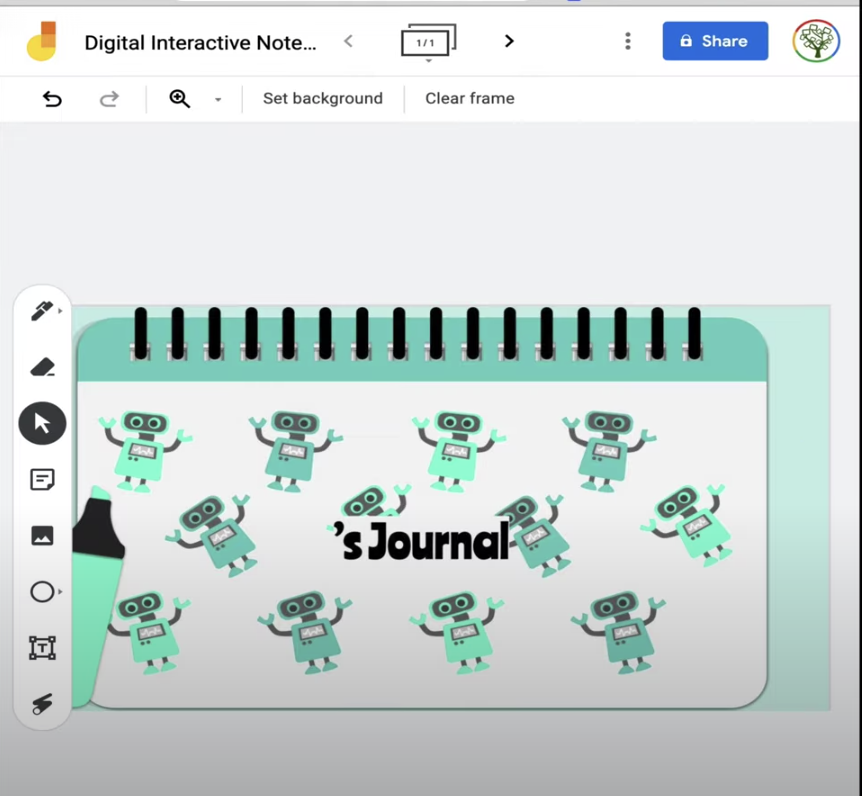
Then to add another frame with a new background, click the next arrow and repeat the process of setting a new background, choosing ‘Image,’ and dragging and dropping the next digital notebook image in.
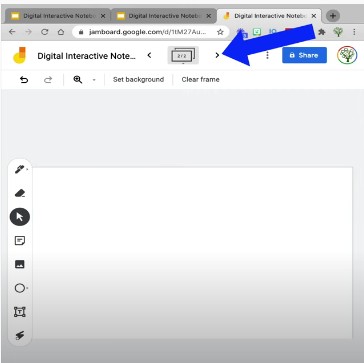
How to Assign Copies of Jamboard Notebooks to Students
Once you’ve set up this Jamboard with all of your notebook slides as backgrounds, you’ll want to assign it to students.
If you’re a Google Classroom user, your best bet will be to head over to Google Classroom where you’ll want to assign this Jamboard as an individual copy for each student. To do this, go up to the Create Button and go down to Assignment.
Be sure to label this Interactive Notebook ‘Student Copy,’ which I’ll explain further in a moment. Then click ‘Add’, find the Jamboard you just created in Google Drive under Recents, and click ‘Insert’. Lastly, click on the dropdown menu and select ‘Make a Copy for Each Student.’
If you use a Learning Management system other than Google Classroom and aren’t able to make individual copies of assignments, another option would be to edit the backend of the link to say ‘copy’ rather than ‘edit’ or ‘view’. This will force-push a copy out to students as soon as they click on the link. Note, however, that students will need to manually share their Jamboards with you if you go this route.

Given that you’ll likely want students to access their notebooks over and over again, I would recommend leaving it unassigned to a topic in Google Classroom.
If you leave it unassigned, you’ll see that the Digital Interactive Notebook “sticks” to the top of the Classwork page. I wouldn’t recommend doing this often, but for assignments like this one that you want students to be able to access over and over again over an extended period of time, it’s the most effective way to pin the assignment to the top of your Google Classroom.
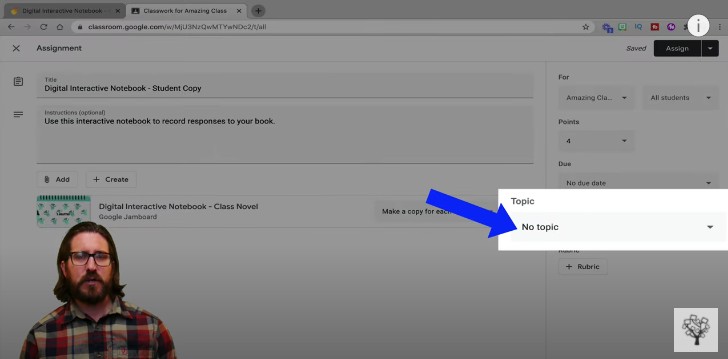
How to Interact with Individual Students' Jamboard Notebooks
Once students start completing their Jamboard notebooks, you’ll be able to see their work by clicking ‘View Assignment,’ selecting a student’s notebook you want to review, and then clicking ‘Open with Google Jamboard.’
If not using Google Classroom, be sure to set up a Google Drive folder where you can keep all of your students’ Jamboards for easy access.
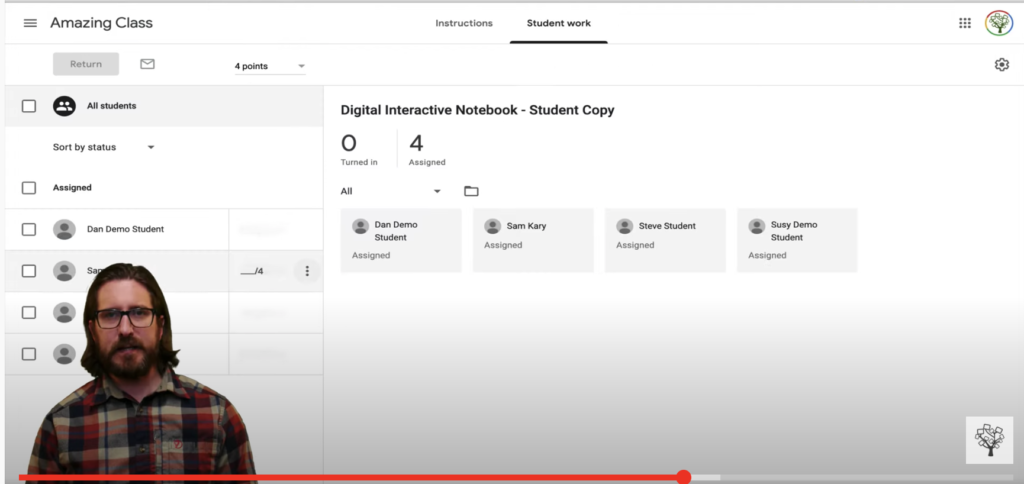
Here you’ll be able to see the work that students have added, and you’ll also be able to easily provide them with feedback in their notebooks. For example, you could leave students a sticky note explaining something that you liked, as well as something you think they could improve.
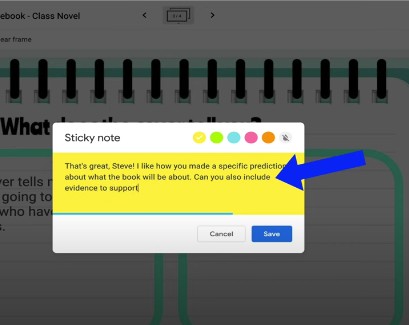
Then, you could set up a system where students have to use the draw tool to put a check next to your feedback to acknowledge they received it as well as add text to revise their responses as needed.
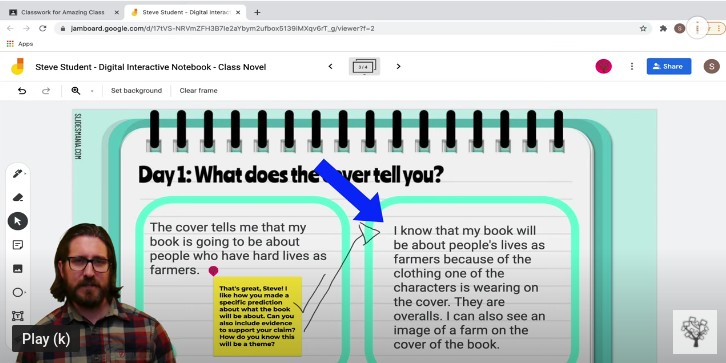
Drip Out New Prompts to Student Digital Notebooks
Lastly, let’s look at how you can continue to add new pages with new prompts to a student’s Jamboard notebook. Note that this step is optional: you could just assign all the notebook prompts at once if you’d prefer.
As mentioned above, I recommend that you build new pages and prompts using your Teacher copy. Once you add a new page, you’ll want to copy and paste it over the Student Slides Copy you already set up.
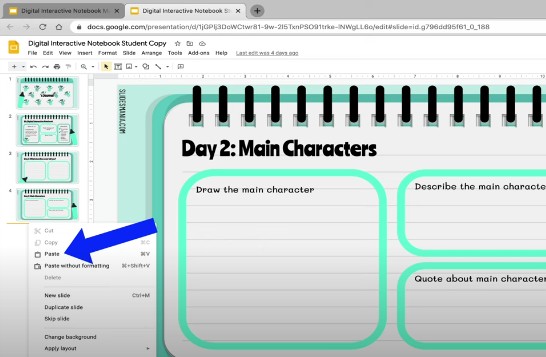
Then, return to Google Classroom to post this new set of Slides so that students can add them as background images to their Jamboard notebooks.
When creating the assignment, title it something like ‘Background Images for Digital Interactive Notebooks.’ Add the Student-Copy Slides from your Google Drive folder, and this time, leave the settings the way they are so that students can only ‘view’ the document.
Just like you did with Jamboard assignment you posted, leave this assignment unassigned to a Topic so that it sticks to the top of Google Classroom.

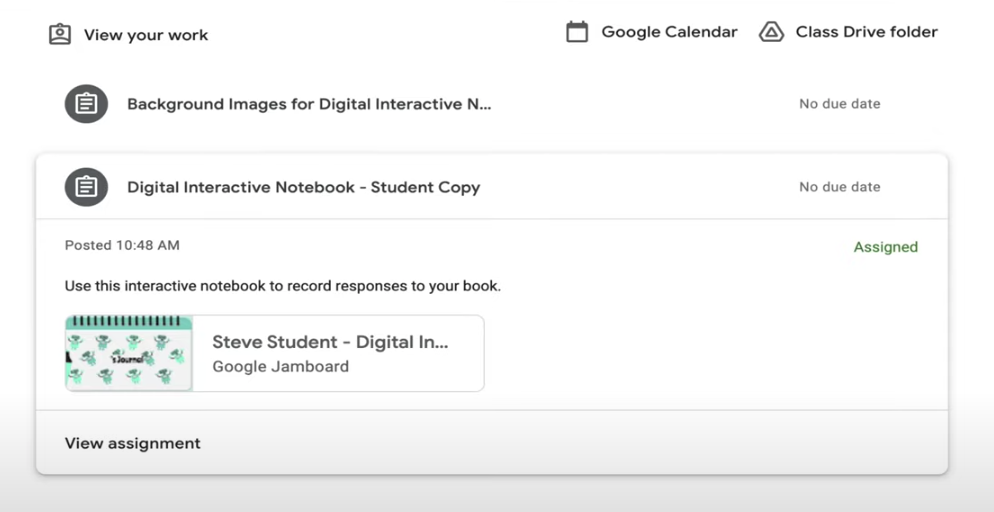
Teach Students How to Add Images as Jamboard Backgrounds
In order for students to bring in the new notebook backgrounds to Jamboard, you’ll need to teach them how to download the image and add it as a Jamboard background. Here, they’ll just repeat the same process you went through to add images to the initial Jamboard you set up.
So have students go to Google Classroom, click on the ‘Background Images’ assignment, and open up the Slides, Show them how to download a Slide as an Image by going up to File -> Download -> Image. Then, have students return to Jamboard, click on the right arrow to add a new page, click ‘Set Background,’ and then select ‘Image’.
Students can either drag files in like we did above, or they can just find the image they downloaded on their computers.
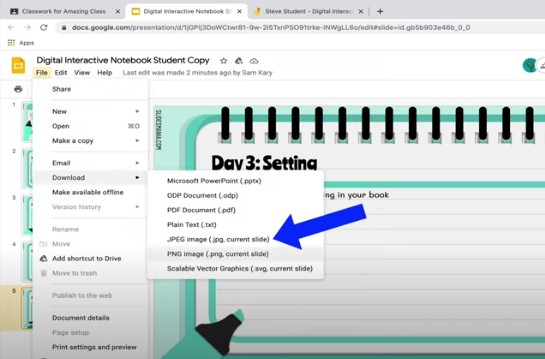
Now, every time you add a new notebook page to your Teacher Slides, copy and paste it over to the Student Version.
Of course rather than giving students pages one by one, you might want to give them a week’s set of pages at a time, and if you wanted to just give them all of their notebook pages at once, that would also be an option.
If you do teach students how to download images and bring them into Jamboard as a background, you’ll also be organically embedding foundational technology skill development, and although it might take students a couple of tries to get the hang of it, eventually they’ll get the hang of it.
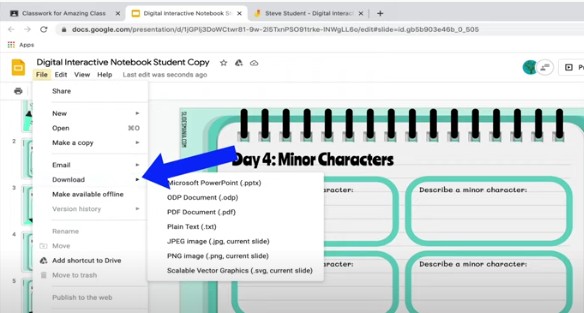
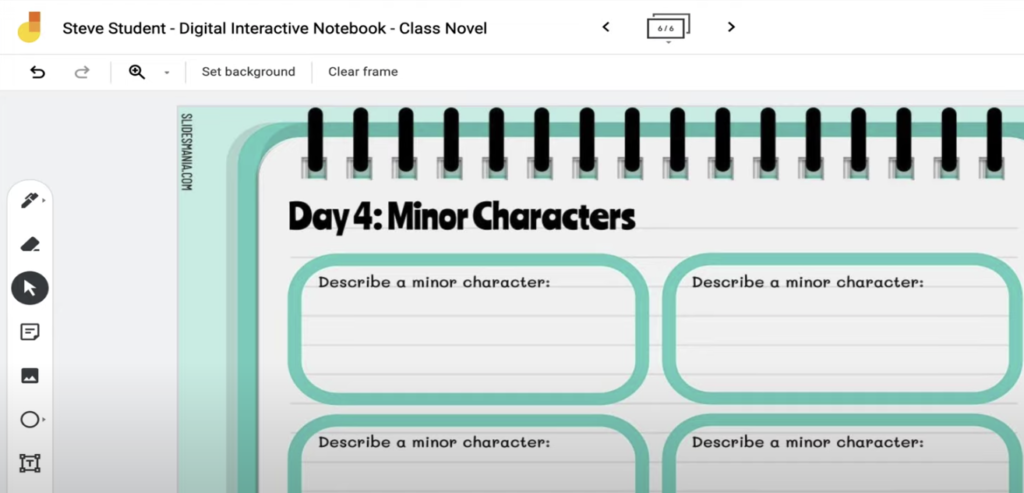
And remember that since you are also the owner of the Jamboard, you could also add the new page to a student’s Jamboard if necessary by going directly into your class Drive folder and clicking on an individual student’s Jamboard.
Conclusion & Resources
Google Jamboard is a notable digital interactive notebook alternative to Google Slides or PowerPoint due to it’s open-canvas style. You and your students can interact freely in Jamboard, making feedback and revisions a simple, intuitive process.
For a comprehensive Google Jamboard tutorial, click here.
To learn about Google Jamboard updates in 2020, click here.
For tips about how to bring in different types of Jamboard backgrounds using Canva Edu, click here.
For additional tips and tricks about teaching with Google Jamboard, check out this live show!
Read this post for a comprehensive take on effective remote learning practices.
For additional strategies for how to use technology to personalize learning, increase engagement, foster creativity, and more, click here.
And to read more about why I believe technology must be a central part of public education today, click here.
Interested in the software I use to create my videos? Check out the links below! Many of these products offer a free trial to start and just clicking on the link helps to support The New EdTech Classroom!
Screenflow is a dynamic, intuitive video editing software that I use to create all of my YouTube videos. They’re currently offering a free trial! Get more details here.
I use Adobe Express to design all of my YouTube thumbnails, as well as all my social media graphics. More information here.
If you’re interested in creating a website, these are a couple of programs I personally use and highly recommend: Bluehost is a web host that offers a professional platform for your website. You can check them out here.
Elementor is a powerful tool that helps with clean visual design for your website as well as marketing to further your website’s influence. More details here.

